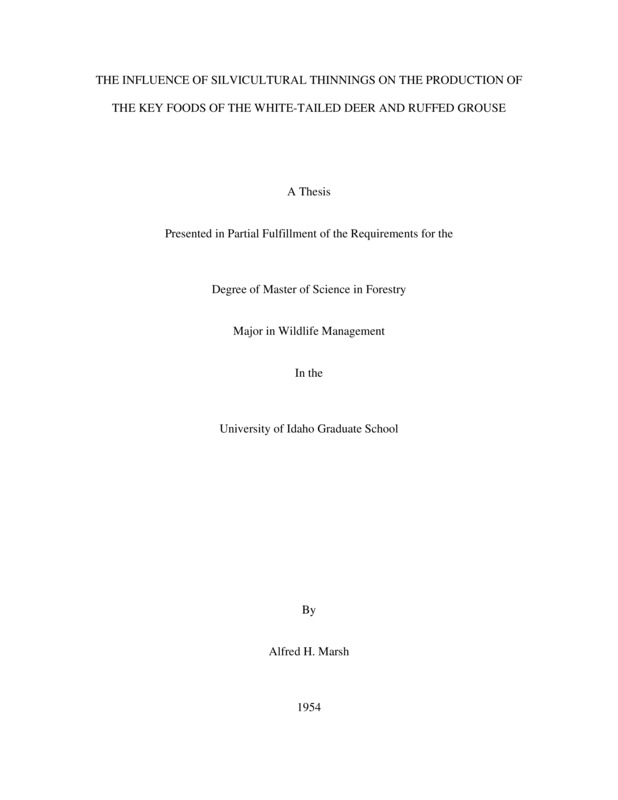PDF PREVIEW
The Influence of Silvicultural Thinnings on the Production of the Key Foods of the White-Tailed Deer and Ruffed Grouse Item Info
- Title:
- The Influence of Silvicultural Thinnings on the Production of the Key Foods of the White-Tailed Deer and Ruffed Grouse
- Creator:
- Marsh, Alfred H.
- Date Created:
- 1954
- Description:
- Five plots were laid out on the University of Idaho Experimental Forest to study the effect of silvicultural thinnings on the production of the key foods of the white-tailed deer and the ruffed grouse. Two of the plots were one-fifth acre in size. One of these was thinned. Three plots were two-fifths acre in size. Two of these plots were thinned. The thinnings removed twelve, eighteen, and twenty-three percent of the basal area originally on the plots. The residential basal areas on all the plots varied from seventy-eight to one hundred and forty square feet per acre. On selected serviceberry stems, the living annual growth for the past four years was measured. Buds and fruiting stalks were counted. Average twig length by plots by years was expressed as a percentage of the 1950 average. Total twig length by plots by years was expressed as a percentage of the 1950 length. The total growth of individual stems for each year was expressed as a percentage of the 1950 growth lumped by plots and the percentages averaged. The total growth of individual plants for 1950-1951 was compared with 1952-1953 as a ratio. The curve of the thinned one-fifth acre plot follows the trend of its control both before and after the thinning. The curves of the two-fifth plots are inconsistent. The ratios were inconsistent within all plots. No significant difference could be demonstrated between the various thinned plots and their respective controls for bud production or number of fruiting stalks. In each plot, nine sub-plots totaling 84.6 square feet were clipped. Grasses, forbs, shrub current growth was harvested. This was dried and weighed. No difference in productivity due to thinning could be demonstrated between the thinned plots and their respective controls. Loop tallies on the foliage and stems within the sub-plots showed that there may have been a slight increase in the occurrence of grasses and sedges. Loop tallies on the litter show that all thinned plots have more conifer (needle) litter than do the controls. The controls in turn have a slightly greater amount of both hardwood litter and herbaceous litter than do the thinned plots. The thinned plots have 135-200 percent more small woody material (less than three-eighths inch in diameter) on the ground than do the controls. List-quadrat tallies were found unsatisfactory for the type of vegetation being studied. Measurements of light grey intensity within the forest were also tried and found inconsistent by the methods used. The shrub and ground-cover data collected two years after the thinning failed to show any difference between thinned and control plots which could be attributed to the thinning. It appears that the differences which exist are due to the inherent qualities of the individual plots.
- Document Type:
- Thesis
- Library Call Number:
- SD396.5.M37
- Subjects:
- ruffed grouse white-tailed deer browse range Flat Creek East Hatter Creek wildlife
- UIEF Unit:
- East Hatter Creek Flat Creek
- Location:
- UIEF; East Hatter Creek; Flat Creek
- Latitude:
- 46.840526
- Longitude:
- -116.780027
- Department:
- Department of Wildlife Resources
- Type:
- Text
- Format:
- application/pdf
Source
- Preferred Citation:
- "The Influence of Silvicultural Thinnings on the Production of the Key Foods of the White-Tailed Deer and Ruffed Grouse", UIEF Research Exchange, University of Idaho Library Digital Collections, https://www.lib.uidaho.edu/digital/uief/items/uief_0128.html
Rights
- Rights:
- In copyright, educational use permitted.
- Standardized Rights:
- http://rightsstatements.org/vocab/InC-EDU/1.0/

